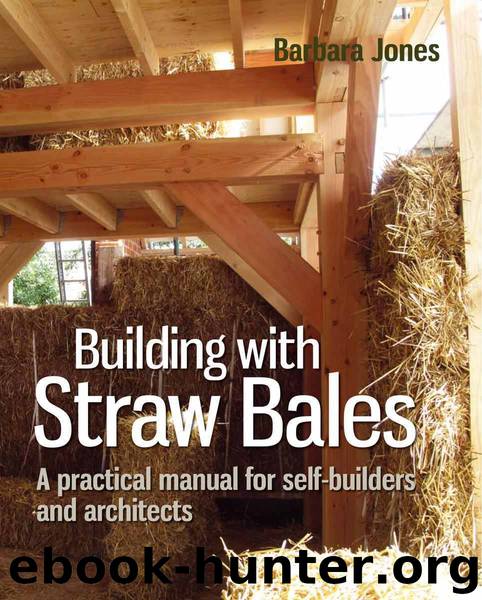Building With Straw Bales by Jones Barbara

Author:Jones, Barbara
Language: eng
Format: epub
ISBN: 9780857842299
Publisher: UIT Cambridge Ltd.
Published: 2015-05-28T16:00:00+00:00
Preparing for plastering
This sounds like a fairly innocuous job but can be one of the hardest and most frustrating, depending on the aesthetic finish you require and the quality of your bales. You’ve done your best to keep the walls straight, you’ve used the best-quality bales you can find, you’ve stuffed all the joints and you’ve compressed the walls and put on the floors and roof. Now you need to trim the walls so that you get as flat a surface as possible without all that hairy straw sticking out. This reduces surface area so that you use far less plaster than you would otherwise; it also reduces the risk of flame spread across the surface of the wall while the building is more vulnerable before plastering. Good tools to use for trimming are a garden strimmer, sharp hedge cutters or clippers, a chainsaw (be careful!) or an alligator saw. The corners and around windows are usually the only places where strings are exposed, so take extra care here not to break them. (Although, as with everything in straw-bale building, there’s always a way round it – just carefully tie string extensions to each end and then retie the string.)
It’s amazing how transformed the building looks once you’ve given it a really good haircut! After trimming, it’s much easier to see if the walls need more straightening, and if there are any joints that still need stuffing. Often some of the stuffing is pulled out by the trimming, but don’t skimp on this part of the process. In all holes and in fact anywhere that you can stuff some tightly packed straw, do it! This may feel a bit laborious, but attention to detail at this point will make a big difference to the heat loss / insulation and airtightness of your building. Of course, you could give up and let the plaster fill all those gaps – many do – but plaster is nowhere near as insulating as straw, and you’ll use a lot of plaster!
This part of the process can take quite a long time, depending on how well you have done all the other parts up until now. Just remember that this is all about long-term durability and very low heating costs in the future. It’s worth it.
Download
This site does not store any files on its server. We only index and link to content provided by other sites. Please contact the content providers to delete copyright contents if any and email us, we'll remove relevant links or contents immediately.
The Body: A Guide for Occupants by Bill Bryson(4953)
Audition by Ryu Murakami(4822)
Adulting by Kelly Williams Brown(4464)
Housekeeping by Marilynne Robinson(4304)
Be in a Treehouse by Pete Nelson(3924)
Zero Waste Home by Bea Johnson(3762)
Seriously... I'm Kidding by Ellen DeGeneres(3564)
Better Homes and Gardens New Cookbook by Better Homes & Gardens(3509)
The Healing Self by Deepak Chopra(3452)
Barkskins by Annie Proulx(3287)
Hedgerow by John Wright(3259)
The Cellar by Natasha Preston(3242)
Spark Joy by Marie Kondo(3231)
The Genius of Japanese Carpentry by Azby Brown(3209)
The Life-Changing Magic Of Tidying Up- The Japanese Art Of Decluttering And Organizing (v5.0) by Marie Kondo(3195)
120 Days of Sodom by Marquis de Sade(3161)
Work Clean by Dan Charnas(3035)
The Book of Numbers by Peter Bentley(2897)
A Monk's Guide to a Clean House and Mind by Shoukei Matsumoto(2855)
